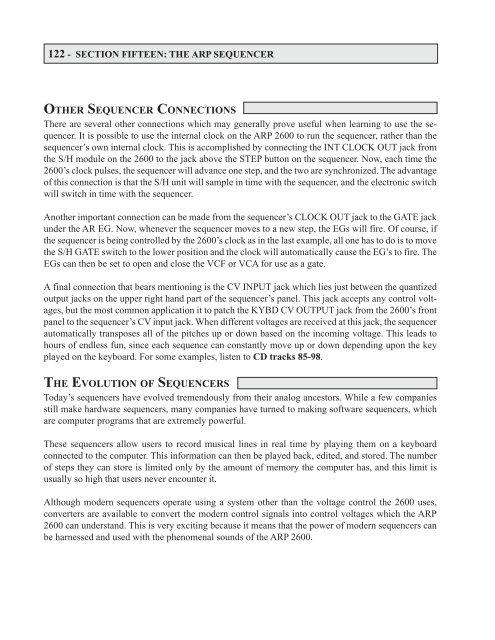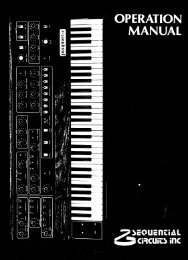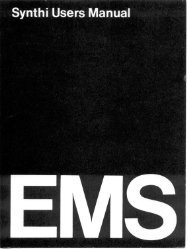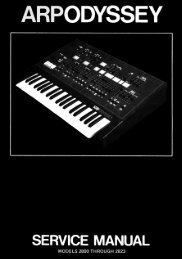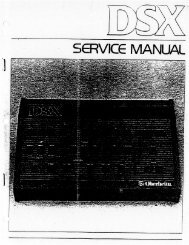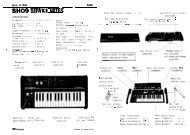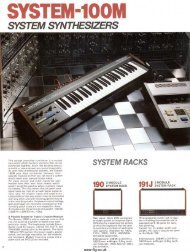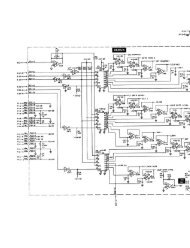ARP2600 - Fundamentals of Music Technology - Cyborgstudio.com
ARP2600 - Fundamentals of Music Technology - Cyborgstudio.com
ARP2600 - Fundamentals of Music Technology - Cyborgstudio.com
You also want an ePaper? Increase the reach of your titles
YUMPU automatically turns print PDFs into web optimized ePapers that Google loves.
122 - SECTION FIFTEEN: THE ARP SEQUENCEROTHER SEQUENCER CONNECTIONSThere are several other connections which may generally prove useful when learning to use the sequencer.It is possible to use the internal clock on the ARP 2600 to run the sequencer, rather than thesequencer’s own internal clock. This is ac<strong>com</strong>plished by connecting the INT CLOCK OUT jack fromthe S/H module on the 2600 to the jack above the STEP button on the sequencer. Now, each time the2600’s clock pulses, the sequencer will advance one step, and the two are synchronized. The advantage<strong>of</strong> this connection is that the S/H unit will sample in time with the sequencer, and the electronic switchwill switch in time with the sequencer.Another important connection can be made from the sequencer’s CLOCK OUT jack to the GATE jackunder the AR EG. Now, whenever the sequencer moves to a new step, the EGs will fire. Of course, ifthe sequencer is being controlled by the 2600’s clock as in the last example, all one has to do is to movethe S/H GATE switch to the lower position and the clock will automatically cause the EG’s to fire. TheEGs can then be set to open and close the VCF or VCA for use as a gate.A final connection that bears mentioning is the CV INPUT jack which lies just between the quantizedoutput jacks on the upper right hand part <strong>of</strong> the sequencer’s panel. This jack accepts any control voltages,but the most <strong>com</strong>mon application it to patch the KYBD CV OUTPUT jack from the 2600’s frontpanel to the sequencer’s CV input jack. When different voltages are received at this jack, the sequencerautomatically transposes all <strong>of</strong> the pitches up or down based on the in<strong>com</strong>ing voltage. This leads tohours <strong>of</strong> endless fun, since each sequence can constantly move up or down depending upon the keyplayed on the keyboard. For some examples, listen to CD tracks 85-98.THE EVOLUTION OF SEQUENCERSToday’s sequencers have evolved tremendously from their analog ancestors. While a few <strong>com</strong>paniesstill make hardware sequencers, many <strong>com</strong>panies have turned to making s<strong>of</strong>tware sequencers, whichare <strong>com</strong>puter programs that are extremely powerful.These sequencers allow users to record musical lines in real time by playing them on a keyboardconnected to the <strong>com</strong>puter. This information can then be played back, edited, and stored. The number<strong>of</strong> steps they can store is limited only by the amount <strong>of</strong> memory the <strong>com</strong>puter has, and this limit isusually so high that users never encounter it.Although modern sequencers operate using a system other than the voltage control the 2600 uses,converters are available to convert the modern control signals into control voltages which the <strong>ARP2600</strong> can understand. This is very exciting because it means that the power <strong>of</strong> modern sequencers canbe harnessed and used with the phenomenal sounds <strong>of</strong> the ARP 2600.


